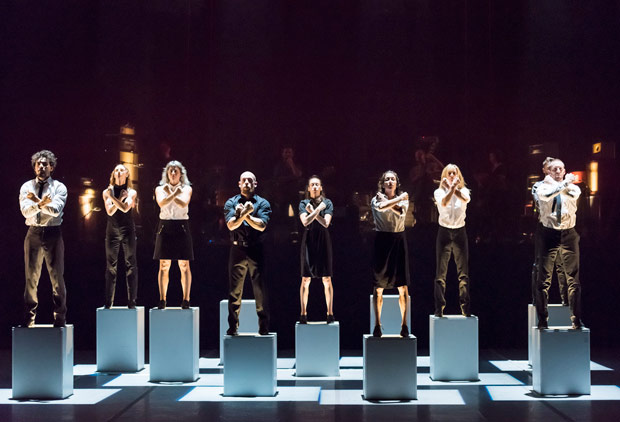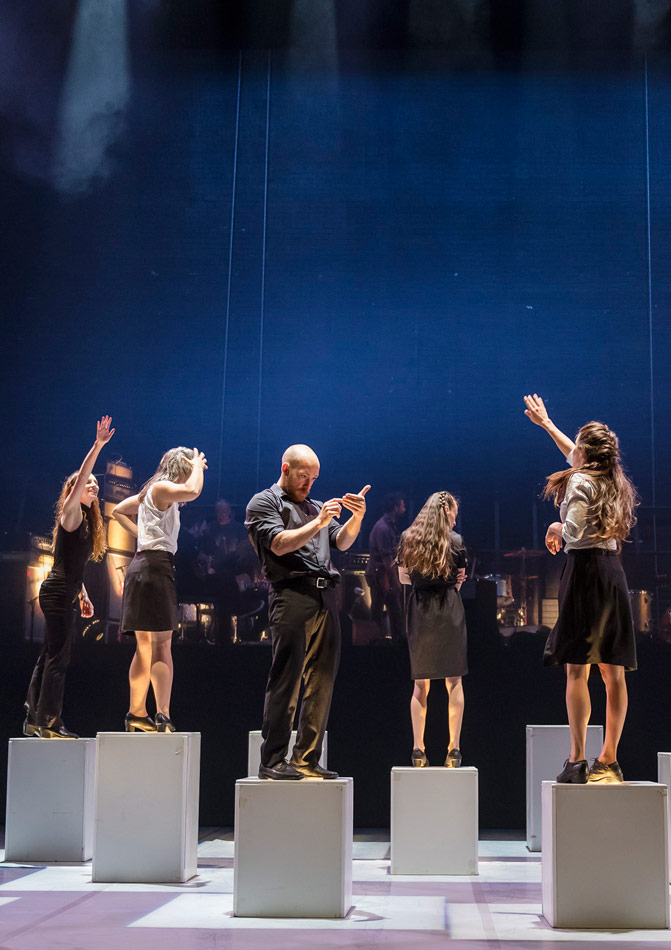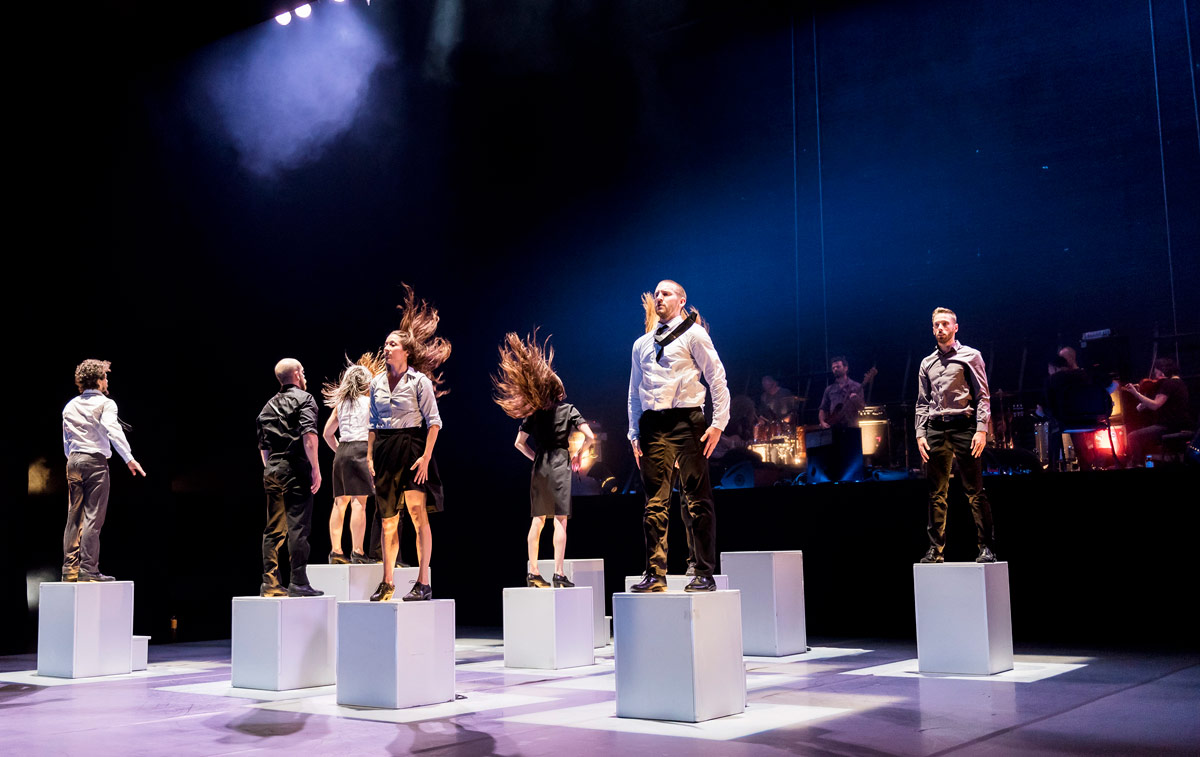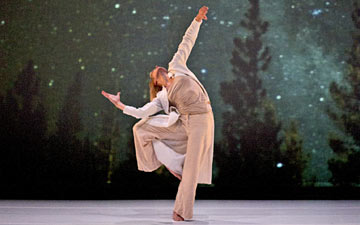
© Jack Vartoogian/FrontRowPhotos. (Click image for larger version)
The Holy Body Tattoo
monumental
★★✰✰✰
17 September 2016
New York, Brooklyn Academy of Music
animalsofdistinction.org
www.bam.org
Critiquing the corporate establishment and its office-imposed culture is nothing new, and plenty of artists, filmmakers and writers have broached the topic before in a myriad of methods. The method chosen by Dana Gingras and Noam Gagnon – founders of Canadian contemporary dance troupe The Holy Body Tattoo – is to watch nine dancers crumble and crack in a restrictive environment ruled by the increasing pressures of the group mentality.
Including text by Jenny Holzer, films by William Morrison and lighting by Marc Parent, monumental debuted in 2005, performed to recorded music by Canadian post-rock pioneers Godspeed You! Black Emperor (GY!BE). The Holy Body Tattoo (THBT) returned to the stage last year after a 10 year hiatus to perform monumental with live accompaniment by GY!BE, and now the work has received its New York premiere at BAM as part of the Next Wave Dance Festival. A highly physical and theatrical entity, THBT have performed their works globally, including in Wuppertal, Germany after an invitation from Pina Bausch.
The piece opens with nine dancers in office attire (the influence of Robert Longo’s “Men in the Cities” is immediately apparent) standing on pedestal cubes. One body starts moving with sharp, jolting movements, and soon the entire group is performing the same repetitive, and frequently violent, self-inflicted gestures. Dancers clasp throats as if choking themselves, hair is stroked hard enough to pull out, stomachs are punched. This goes on, with minimal variation, for a significant amount of time. Restriction, constriction and fear are communicated through these movements, helplessness with a slouch. The violence continues for the course of the piece, eventually resulting in bodies collapsed on the floor, finally off the pedestal, and some extraordinary physical feats performed at the very end – part of THBT’s ethos is to push the dancers to the point of exhaustion. There are times when you wonder if bones have been broken, or organs perforated. On the whole however, the hour and a half work is largely characterised by the violent, repetitive and neurotic gestures.
Holzer’s text projections serve as warnings: “It’s wise to be on guard if you’re always surrounded by people who are compelled to be nice to you….” and GY!BE’s accompaniment is doom-laden and penetrating.

© Jack Vartoogian/FrontRowPhotos. (Click image for larger version)
In an interview with the Atlantic, Gingras sites the “everyday actions” of people going to and from work, and “how we come together to make things happen and work” as “monumental.” But for most people, suiting up for work, trudging up and down the subway stairs (or sitting in traffic), tussling with thousands of people in the massive throngs to get to spend a day under fluorescent lighting and smile their way through unnecessary meetings is not monumental: it is reality. Depending on the circumstances, most people make this deal with the proverbial devil in order to feed themselves, their families, earn a paycheck, receive health care (in America at least career choices can be influenced by health care options) and maybe a retirement plan. The grind is also not unique to corporate culture. Thanks to human nature’s imperfections, the pressures to fit in, keep quiet, do as you are told and not contradict the powers that be are just as frequent in other sectors. Nonprofits and education – among others – come to mind as they are often at the mercy of boards of directors wielding enormous amounts of power, and may or may not have first hand experience at what they oversee.
monumental, with its film projections of busy highways and high rise buildings, can also seem more of a J.G. Ballard-esque critique of urban modernist architecture than “corporate survival.” While there is no absolutely conclusive evidence, some studies have shown an increase in mental illness with the increase in elevation in high-rise dwellings (Goodman, 1974). It could be said that this is as much an influence on unhappiness in society as conforming to the norms of a corporate workforce.
Gingras says “isolation is at the heart of the piece,” but there are more factors contributing to alienation in the modern world than corporate office culture and capitalism’s ruthless embrace of it. monumental’s descent into violent chaos is more of a critique of human nature, a la “Lord of the Flies” than saying anything specific about how corporate culture and our increasingly tech-oriented world drives such madness. The dancers are agitated from the beginning, and while the action grows increasingly violent, it doesn’t really change significantly until the very end with a hard spike, and the work lacks the right pacing to create any kind of effective arc; it is brutal from start to finish.
Many audience members left, some at the beginning, some halfway through, some towards the end. Some artists might consider this a badge of honor, to have agitated an audience to the extreme: they got it so intensely they had to leave, it was too visceral. At one point pairs of dancers split into more personal, less pack influenced, acts of violence and sex (at least one couple alternated between copulation and trying to kill each other). After witnessing two significant acts of domestic violence on the New York subway two days in a row, I can’t say that I blame those who abandoned ship.

© Jack Vartoogian/FrontRowPhotos. (Click image for larger version)
At the end monumental lacks the articulation I was hoping for after reading the preliminary press releases suggesting a critique of corporate, capitalistic culture. Towards the end, a voice stated “…the government is corrupt…we’re trapped in the machine…” Instead of making monumental poignant, the spoken word element sealed the deal as being overwrought. Depending on execution, dance may not always be the best medium for such critiques, and after 90 minutes of exhausting repetition, a night reading Chomsky, Zinn or watching “Office Space” seems equally effective (and more pleasurable, not that all art must serve pleasure).
Humanity is a tricky thing, fights can start within families and next door neighbors, corporate culture alone is not responsible for man’s dissatisfaction in the modern world. That said, it is nearly impossible to deny that cubicle culture, and the daily grind, has an unhealthy influence on the human psyche and in today’s society we are constantly seeking new ways to cope (yoga, the rise of “unplugging” culture,etc.). Nevertheless, the first thing I thought of after exiting monumental was realizing that the first flowers I ever received as an adult, were not given to me by a boyfriend or paramour, they were given to me – post operation – by a cubicle coworker.

















You must be logged in to post a comment.